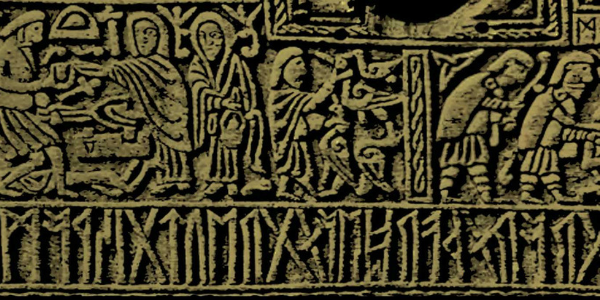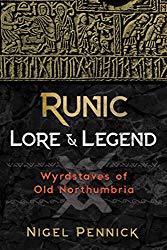
Runic Lore and Legend: Wyrdstaves of Old Northumbria, by Nigel Pennick
Destiny Books, 9781620557563, 176 pp., 2019
As we continue our march towards monoculture, we obviously stand to lose a great deal, and one of many things under threat is the specificity and unique nature of sacred places. Nigel Pennick’s work, Runic Lore and Legend: Wyrdstaves of Old Northumbria, stands as a primer to the magical landscape and history of the ancient kingdom of Northumbria, and is a testament to Pennick’s deep knowledge and love for this land.
Northumbria was an independent kingdom in early Anglo-Saxon Britain, stretching from the Humber River north to the Firth of Forth, which is now in Scotland. Its territories were the subject of the earliest Viking raids into the British Isles, and over the course of the decades that followed there developed a remarkable fusion of Norse and local cultures and traditions unique to the area.
One of the interesting developments of this cultural fusion was the creation of a hybrid system of runes, and this serves as Pennick’s entry point into Northumbria’s sacred geography. The most common and well known runic system is the Elder Futhark, the 24 character rune alphabet that is the inspiration for most modern divinatory rune systems. However, this alphabet changed and spread over time, and the system that developed in Great Britain is known variously as the Anglo-Saxon Futhark, the Anglo-Saxon Futhorc, and the Anglo-Frisian Futhark. It comprises 33 runes, which Pennick examines in detail, devoting half a page or more to each rune. For students of the Elder Futhark, there will be much that is familiar, although with both interesting variations (the transformation of ansuzto os, and a corresponding emphasis on “breath” as sacred), and the addition of new symbols (such as yr-yew bow, stan-stone, and cweorth-ritual fire). This section comprises approximately a third of the book overall.
Although this section is informative, and of particular interest to students of runic systems, the special charm of the book really resides in his other material. This book serves as a primer for magical traditions and locations throughout Northumbria, from the ancient world to the modern day. Pennick is interested in delivering a magicalhistory and geography of Northumbria, and his attitude is work quoting in full:
The magical elements in these accounts are discounted by academic historians because they do not fit in with their narratives. Equally, with accounts of holy people and saints, the miraculous parts of their stories are unacceptable, even to many clerics. So they have been expunged from history. But all history in the days before the rise of the academic historian was infused with supernatural and magical events – ostenta– the working of gods and providence. Magical and supernatural events were accorded equal status with events that appear mundane. The legendary history of every nation is full of such accounts, and scriptures held as sacred by their devotees are almost entirely composed of such legendary history. The stories of the Celtic saints, for example, run the whole gamut of supernatural happenings: divination, ostenta, oracles, distant viewing, apparitions of angels and otherworldly beasts, the use of magical objects, healings, bilocation, teleportation, psychic battles with demons, and divine intervention. These stories encapsulate the practices of magic and the mantic arts of the period, which were then integral parts of everyday life, for the magical worldview was present among all, regardless of the ethnicity or religion to which they belonged.1
This attitude stands as a rebuke and a corrective to the practices of academic historians who seek to portray historical figures as exclusively “rational” actors reading from a post-Enlightenment script. This practice acts as a kind of erasure and correspondingly fails to adequately explain the actions of actors who held what Pennick describes as a “magical worldview.” Just as an example, anyone who attempts to explain the Peasants’ Crusade as a movement of rational actors has missed the point just as much as anyone who simply characterizes it as “mass hysteria.” (Although the group that followed a goose, they believed to be inspired by the Holy Spirit? Maybe magical thinking, but maybe just a really stupid village.)
In this context, reading Pennick’s magical history and geography of Northumbria is akin to holding a map over a candle and watching the sections in invisible ink reappear. He gives us raven banners and outlaw archers, demonic nobles and sacred wells, and of course the remarkable Lambton Worm. What Nigel Pennick manages in this book is to restore a sense of wonder, to show the enduring power of stories, and in the process to enrich both a historical landscape as well as his readership. Runic Lore and Legend makes the world a little less dreary and a little more magical.
- p. 100 [↩]









